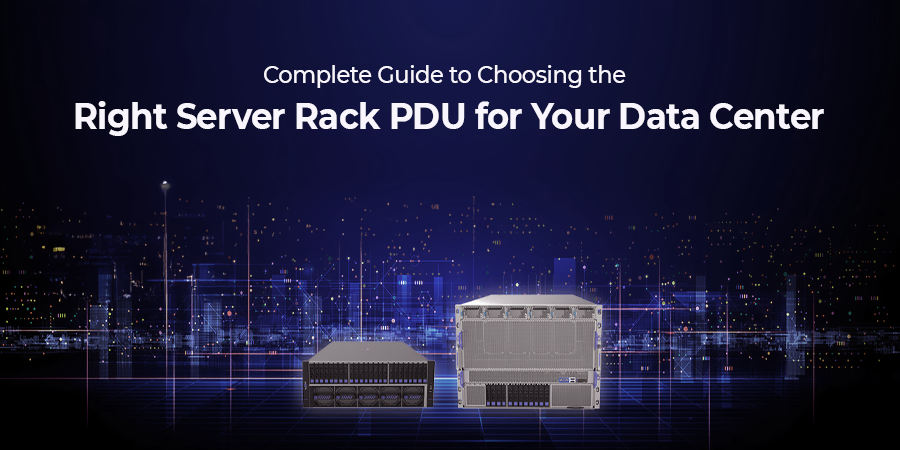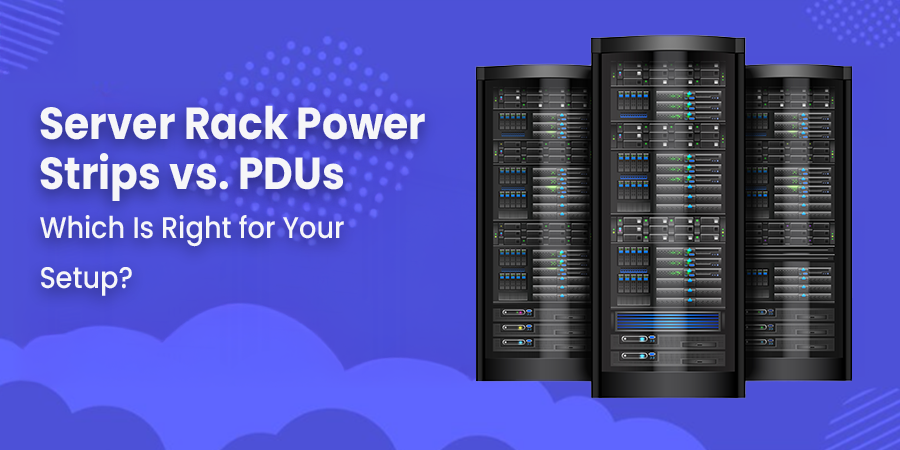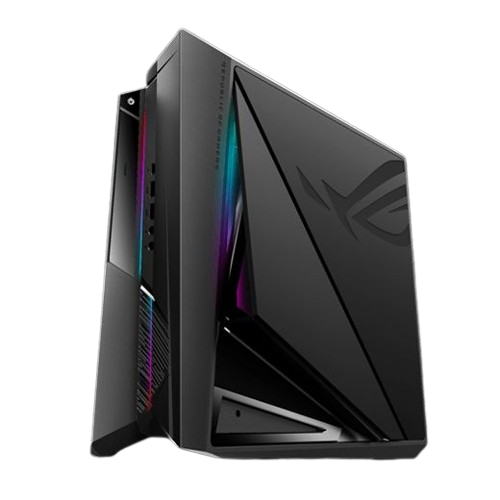Complete Guide to Choosing the Right Server Rack PDU for Your Data Centre

Server Tech Central
9/23/2025

Introduction
Why is there so much emphasis on power supply in the modern data centers? The power design of a data center needs careful attention. It distributes electrical power to the main IT equipment inside the data center. With the growing complexities and expansions, power equipment has become an indispensable component of network infrastructure. Modern AI models and edge computing draw up to 15 times the power of conventional systems. It is important to use the right power source. This helps ensure reliable power, optimize energy use, and improve overall efficiency.
It can be a difficult task. It needs careful thought about power efficiency, protecting equipment, and balancing the load. Managing too many cables at once can also be problematic, as it might disrupt the seamless performance. The right server rack is crucial, as it can save an organization from potential downtime and overloads. Here’s where the Server Rack PDU (Power Distribution Unit) plays a vital role. It is a smart unit that gives stable and safe power to many devices from one power source. It does this without causing any interruptions.
What is a Server Rack PDU?
A server rack PDU (Power Distribution Unit) holds networking equipment. This includes servers, modems, UPS units, routers, network switches, and audio and video gear. They are special computer cases, wall-mount racks, standing frames, or server cabinets. These hold the networking equipment.
Large data centers deploy large racks that can accommodate multiple servers, providing power, cooling, and connectivity. They are replaceable and expandable in case of failure.
Key Features of Server Rack PDU
The key features of PDU include:
Reliable Power Distribution:
PDUs ensure stable and safe power delivery to multiple devices from a single power source. Without PDUs, managing several power cords and sources would be chaotic and unsafe.
Space and Cable Management:
Rack-mounted PDUs fit in standard 19” racks that help to keep cabling organized, reducing clutter and improving airflow.
Power Monitoring and Management:
Advanced PDUs allow real-time monitoring of:
Power Usage
Load Balancing
Environmental Conditions
Redundancy and Uptime:
Data centers use dual PDUs, where each is connected to a separate UPS system for redundancy. If one fails to perform, the other ensures continuous operation and reduces downtime.
Remote Monitoring or Centralized Controlling:
Intelligent PDUs ensure remote monitoring or switching that allows IT teams to:
Respond quickly to a power disruption
Troubleshooting without physical presence
Comparison With The Rest In the Market
Why Choosing the Right PDU Matters
Every organization feels pressure to manage power effectively. It is essential, not only for environmental responsibilities but also to reduce operational costs. Highly virtualized environments are limiting the number of servers, but the servers in use consume more power. Additionally, large organizations are adopting blade servers and implementing standardized data center designs across their enterprises.
As data centers have become more informed and centralized, power management should also become feasible. To support this, PDUs across all data centers can provide significant benefits.
Types of PDUs
When looking for a PDU, it is essential to understand the various options available. Then, you can determine the right server rack PDU that suits your organization's needs.
Type of PDU | Description | Ideal For |
Basic PDUs | They are the simplest ones, providing a straightforward power distribution to several devices without any advanced features. They are relatively cost-effective and reliable for small setups. They include circuit protection. | Small Setups Test Environments Stable Infrastructures |
Metered PDUs | They have real-time power metrics (voltage, current, kW) on a screen to monitor power consumption. | Ideal for organizations that require power monitoring but not remote management. |
Monitored PDUs | They offer the most advanced features, including remote monitoring, power management, load balancing, and environmental tracking. They can be managed and controlled remotely, as they provide real-time signals and a detailed power data overview. | Ideal for large and mission-critical data centers that require high availability and energy optimization. |
Switched PDUs | They offer remote control of individual outlets. Supports power cycling, remote shutdowns, and usage optimization. | Multi-site IT operations, remote offices, or unnamed server locations that need complete control. |
ATS PDUs | They provide automatic failover between two power sources for single-corded devices. | Ideal for legacy systems, server message block racks, and telecom closets. |
Hot-Swappable PDUs | They work in the replacement or maintenance of a connected UPS, but without any downtime. | Ideal for mission-critical applications. |
Key Factors to Consider When Choosing a PDU
Multiple factors influence the PDU, including its configurations and features. You need to be vigilant in understanding the needs of your organization and the features of a specific PDU. Here is a brief guide that navigates through the key aspects of choosing the right server rack PDU.
1. Power Capacity:
Understanding the power consumption of your device is essential to prevent overloading and downtime. Distribution ratings are 15A, 20A, 30A, and up to 100A.
Single-phase PDUs are used in offices.
Three-phase PDUs are best for high-density data centers that require scalability. It also supports AI workloads and compute-intensive infrastructure.
2. Installation and Mounting
The installation and mounting of PDUs play a significant role in rack organization, airflow, accessibility, and overall space efficiency. Here are a few more ways to install a PDU.
Rack-mounted PDUs: They are installed horizontally (1U/2U) or vertically (OU) inside server racks.
Wall-mounted PDUs: They are ideal for compact and advanced setups where rack space is limited.
Standalone PDUs: They are floor-based units designed for high-voltage industrial environments.
3. Voltage Compatibility
For seamless operation, you need to match your PDU to your facility’s power configuration. It protects your device from voltage instability and power interruptions.
4. Monitoring and Remote Control
Remote access provides proactive engagement and quicker response. Look for SNMP, HTTP, and Telnet support and integrate with DCIM platforms for deep insights.
5. EMI Filters
EMI filters reduce electromagnetic interference that can affect the equipment. They are ideal for industrial applications.
6. Built-in Display/Control Board
The display shows the power or voltage statistics, which help in monitoring the PDU's functionality. Always look for LCD or OLED panels that present real-time data.
7. Reliability and Brand Quality
High-quality PDU purchase depends on a reliable provider. You need to find a trusted provider. If you don’t know any, Server Tech Central is a great choice. We specialize in efficient Power Distribution Units. They provide the best output without going over your budget.
Common Mistakes To Avoid
You need to be very careful when choosing the right PDU. The success of your organization relies on the quality of the power source. You are supposed to avoid a few mistakes.
Overlooking future scalability
Mismatched plug types and voltage ratings
Ignoring form factor and mounting options
Choosing the wrong PDU type
Avoiding power requirements
Not consulting the expert
Neglecting network management capabilities
Industry Recommendations and Best Practices
Choosing the right PDU is important. It helps with efficient, scalable, and secure data center operations. For industry leaders and data center professionals, the following best practices are recommended for optimal performance.
Conducting a thorough power assessment
Use Metered and Monitored PDUs for visibility
Switched PDUs are best for remote control
Implement environmental monitoring.
Integrate with DCIM Tools
Ensure proper cable management.
Choose a trusted provider
Final Thought
Choosing the right PDU is not just about providing power. It is important for a reliable, manageable, and future-ready power system. Choosing the right server rack PDU helps with power distribution. It also allows for managing, monitoring, and visualizing power use. This ensures smooth device performance in data centers. They provide you with real-time data and analysis about the voltage utility.
Additionally, with the proactive approach, you can access and balance the load before any power disruption happens. In the event of a power issue, you can remotely resolve the issue. By using this guide, you can choose the right server rack PDU for your data center needs.




